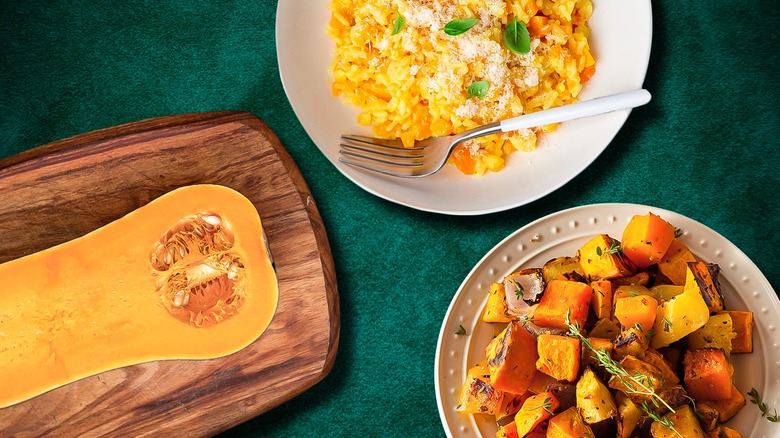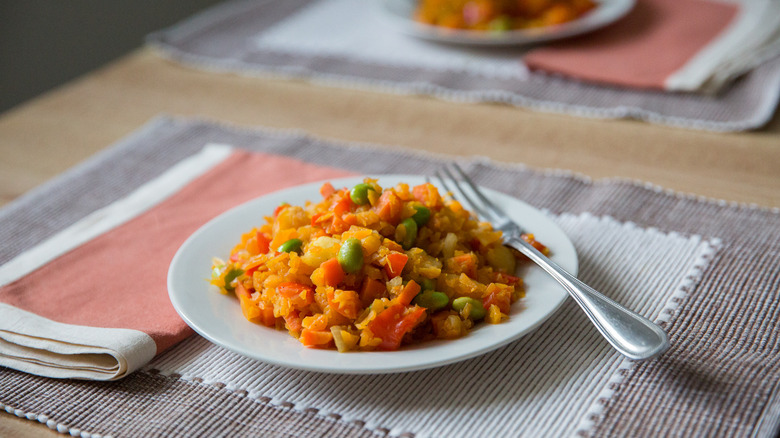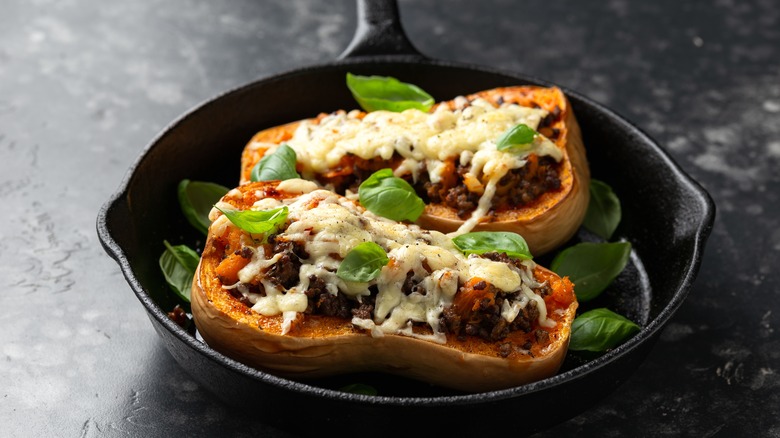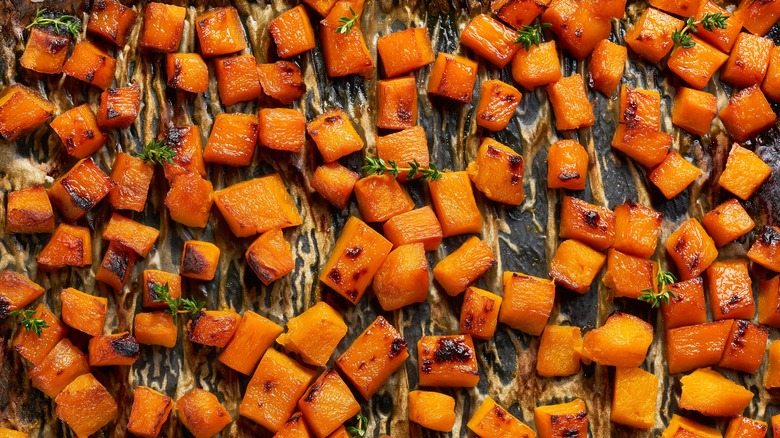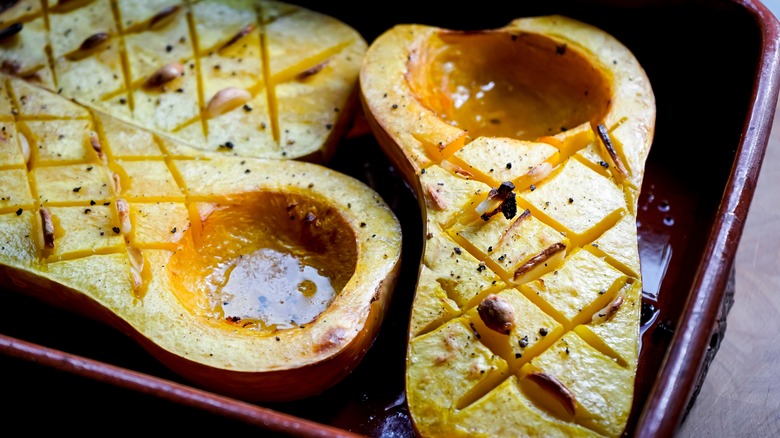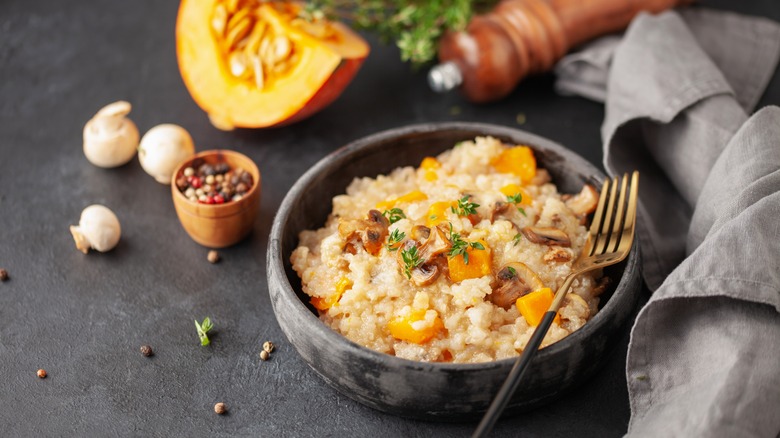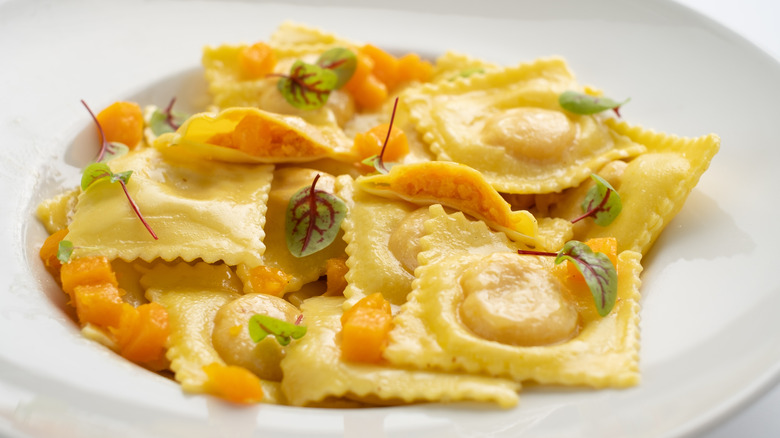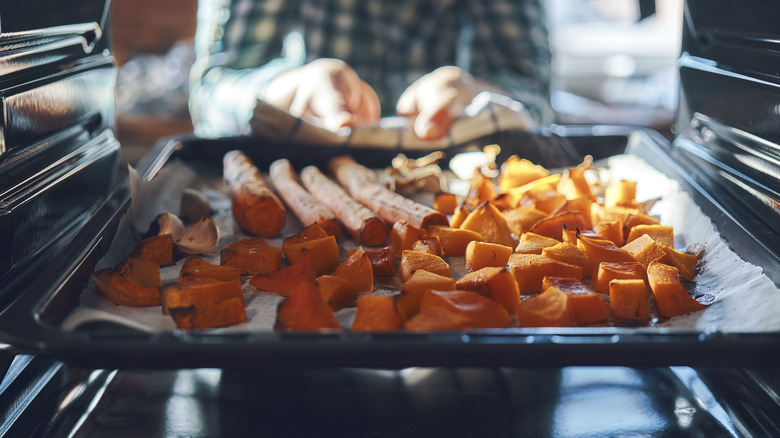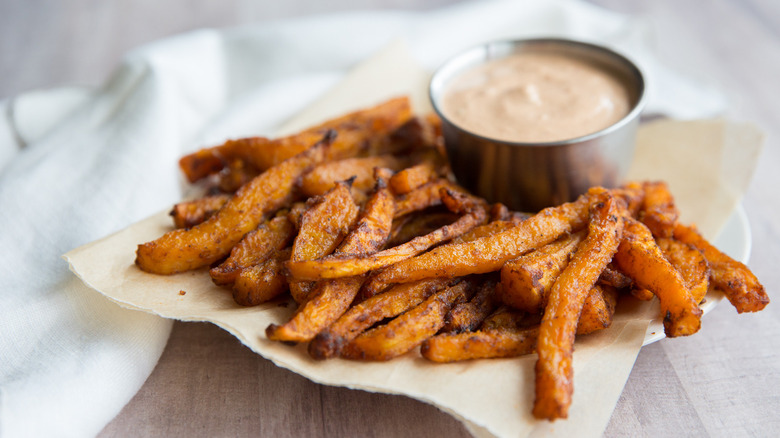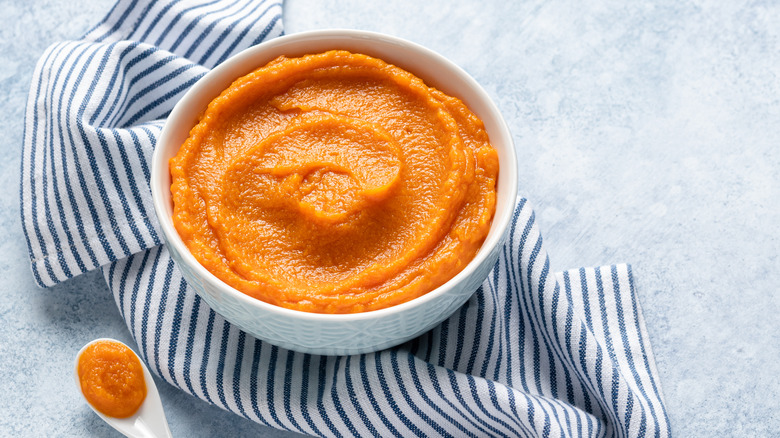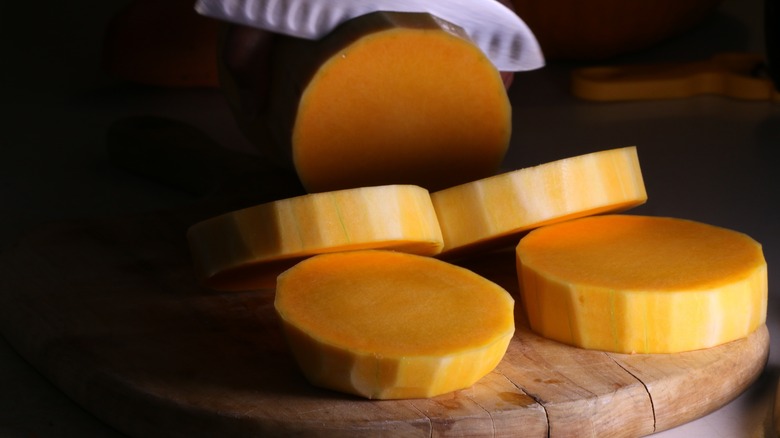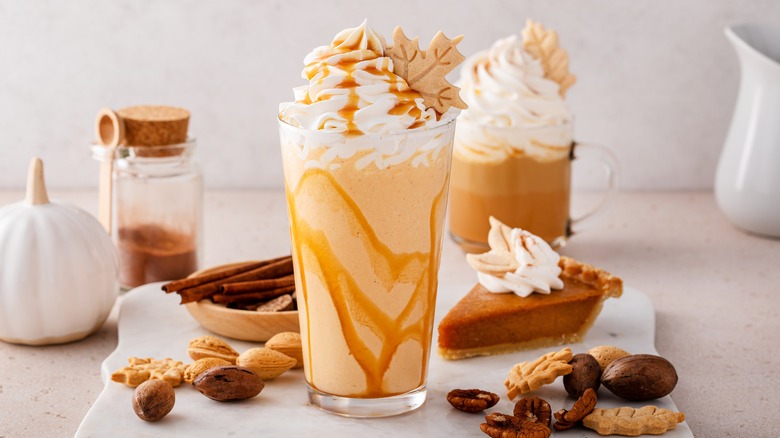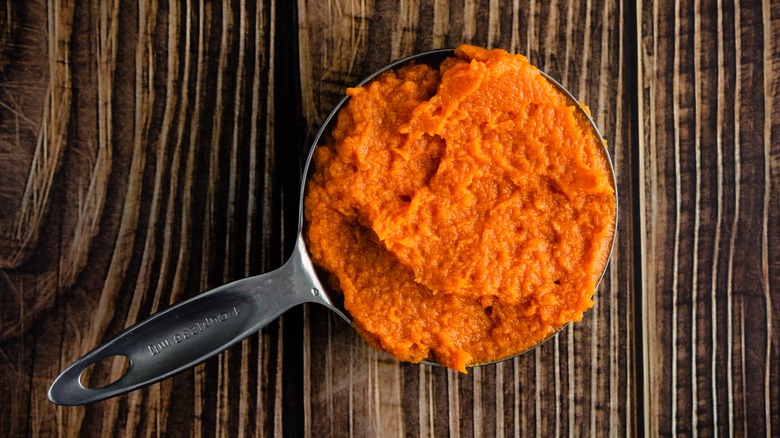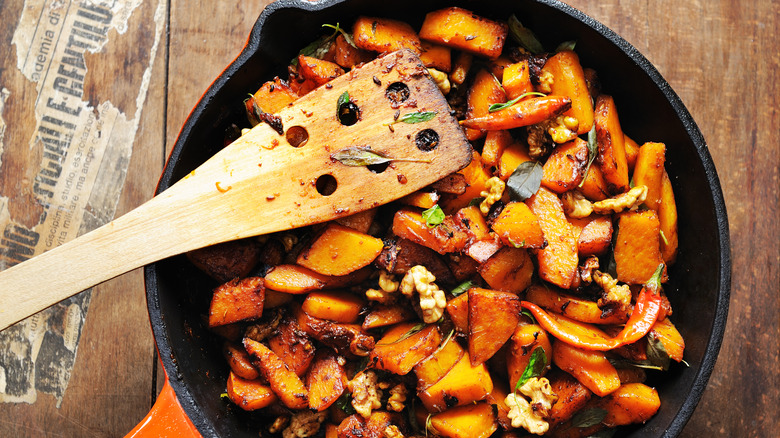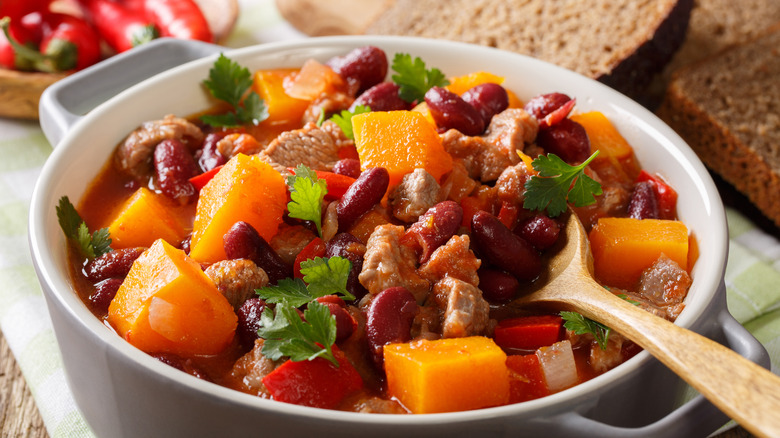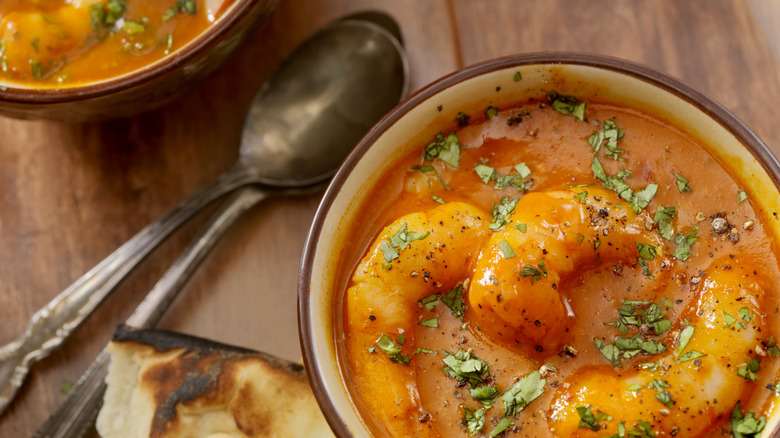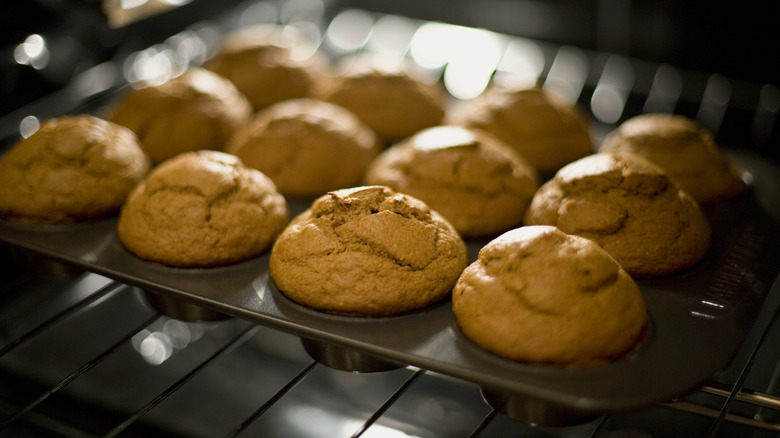18 Creative Ways To Use Butternut Squash That Aren't Soup
Butternut squash is a common winter squash with an elongated shape, pale skin, and vibrant orange flesh. Like the name suggests, these vegetables have a rich, creamy texture and nutty flavor that's often described as subtly sweet, which can be enhanced with cooking techniques that promote caramelization. This squash variety may be among the least expensive items at the grocery store, but it's a versatile ingredient that can wear many hats.
Now, while butternut squash is simple to prepare once it's peeled, some people may only be familiar with it in soup. Of course, butternut squash soup is certainly delicious, yet there are many more ways of preparing this humble vegetable — some classic, some quite unexpected — that are definitely worth trying. With that in mind, if you're willing to branch out and explore how to make this tasty ingredient shine, we've gathered 18 creative ways of using butternut squash that aren't soup.
Pulse it to make fried rice
Fried rice is well-known around the world, but sometimes carb-conscious cooks look for creative substitutes for this comforting staple. You may have heard of cauliflower "rice," but have you considered using butternut squash instead? If not, we assure you: it works just as well as other veggie options. You can even opt to purchase pre-peeled and chopped butternut squash from the supermarket rather than peeling a whole vegetable, if desired.
The secret is to first pulse the butternut squash chunks in the food processor until the pieces are small enough to resemble rice. Then you can fry them with other ingredients just like you would with fried rice. This autumnal butternut squash fried rice recipe is a deliciously sweet and savory take on the classic, incorporating creative additions like edamame and apple.
Stuff it for a vegetarian main course
If you've never tried stuffed butternut squash, you're in for a treat. This hearty dish is often seen as a vegetarian or vegan alternative to Thanksgiving turkey. The preparation is on the easier side, as well, since the squash doesn't need to be peeled. Simply slice it in half, hollow out the seed cavity, and roast it face down on a baking sheet.
Once roasted, you can add cooked fillings. Think grains like wild rice, quinoa, and farro; vegetables like mushrooms, kale, and spinach; and herbs like thyme, oregano, and sage. This dish lends itself well to completely plant-based versions. Of course, cooks can also opt to include cheeses like grated Parmesan or crumbled feta, then pop the squash back in the oven for a few final minutes to melt the cheese and meld all the flavors.
Roast cubed butternut squash
Roasting butternut squash is an extremely popular way of preparing this hardy vegetable. With recipes ranging from roasted butternut squash flatbread and butternut squash and bacon quiche to a roasted butternut squash Sichuan stir-fry, there's really no shortage of options. The effort to peel and cube the vegetable before roasting will pay off, too, and the resulting flavor-packed pieces are perfect for a variety of dishes.
Roasted butternut squash cubes can be used in salads, as a topping for bruschetta, or added to couscous and pasta. Pizza, tacos, stuffed shells, and hummus can all be enhanced with this deliciously crispy and caramelized ingredient. Even surprising dishes like bread pudding can be made better with roasted butternut squash, like in this creative winter squash bread and butter pudding recipe.
Bake the whole squash
While butternut squash is often peeled and chopped, baking the whole vegetable can be advantageous. Well, almost whole, as it's generally cut in half first to remove the seeds. You can bake the halves plain or slather them with tasty ingredients like olive oil, honey, and warm spices (such as cinnamon, cumin, and ginger).
Now, the baked squash is delicious to eat as is — especially if seasoned first — but it's also a convenient way to prepare it for other uses. It's a cinch to scoop out the flesh with a spoon for recipes calling for pureed squash. Plus, as long as you don't overcook it or make it too soft, you can peel and cube the baked halves for when you need cooked cubed squash. It's much easier to peel and cut after baking, after all.
Make risotto
Risotto is an Italian rice dish that's slow cooked in broth until creamy. Risotto can be made with many different kinds of vegetables — including peas, radicchio, mushrooms, zucchini, spinach, and asparagus (just to name a few) — and usually includes cheese and butter for added richness. Since the sweet flavor of soft, cooked butternut squash complements the similarly textured risotto, it makes an excellent addition to this Italian staple.
One way to make it is to follow this roasted garlic and butternut squash risotto recipe. The rice is toasted with butter and shallots before adding a wine and vegetable or chicken broth. Once the rice is cooked, stir in the cubed squash, Parmesan, sage, and roasted garlic before serving. The melted cheese, strong herby sage, nutty roasted garlic, and caramelized squash blend with the rice and enhance the whole of this truly comforting dish.
Craft fresh pasta dishes
Risotto isn't the only Italian dish that can benefit from the addition of butternut squash. For instance, you can also make a filling for butternut squash ravioli with pureed roasted squash and ingredients like Parmesan cheese, nutmeg, hazelnuts, and even amaretti cookies to complement the sweetness of the squash. This filling is inserted into homemade ravioli and often served with a simple butter sage sauce.
You can also use pureed squash as a layer when making lasagna for a veggie-heavy version of the popular Italian dish. Spread the puree over lasagna noodles, alternating it with other vegetable layers that could include Brussels sprouts, mushrooms, ricotta cheese, béchamel sauce, and mozzarella cheese.
Gnocchi is a third Italian dish that can be made with this vegetable. Mix pureed butternut squash with Parmesan or other cheeses, eggs, salt, pepper, and flour to form a soft dough that can be dropped by the spoonful into boiling water.
Use butternut squash in a sandwich
If you've never thought about including butternut squash in a sandwich, you're not alone. However, the smooth texture, light flavor, and heartiness of this fiber-packed ingredient help create to an extra filling and delicious (not to mention unique) sandwich. Thick slices of roasted squash are ideal for sandwiches, as they hold up well and can be stacked with other standard fixings.
Try pairing butternut squash on a sandwich with caramelized onions, pesto, roasted red pepper, spinach, Brie, or even cranberry sauce (for a fall-themed treat). Another way to use the vegetable is to puree it and spread it on bread like you would do with hummus or mayonnaise. You have many options if you go this route. For example, you can blend it with carrots, onion, and spices, such as nutmeg or cumin, or try it with garlic, cream cheese, and fresh herbs for a richer version.
Make butternut squash fries
Potatoes are king when it comes to french fries, but they're hardly the only way to enjoy this salty treat. If you're curious to try alternatives to the standard potato, other vegetable options that work just as well include turnips, carrots, and — you guessed it — butternut squash.
Most of the effort will be spent peeling and cutting the raw squash into equal-sized matchstick shapes, which will ensure they all cook and crisp up at the same rate. The secret is to toss the raw sticks with cornstarch to ensure they get extra crispy, before tossing them again with your favorite spices. We recommend paprika, cumin, garlic powder, salt, and pepper as a good starting point. All that's left is to bake the fries and serve them with your favorite dipping sauce.
Mash it
There's a new kid in town, mashed potato fans — and it's mashed butternut squash. Tender and creamy, with a vibrant orange color, this is mashed potato's equal on the Thanksgiving table. In fact, whether it's a savory recipe with garlic, butter, and cheese, or a sweetened version with maple syrup and cinnamon, however you prefer to dress mashed potatoes? You can do with butternut squash, too.
If you've previously passed over this option to avoid having to peel the vegetable, there's actually no peeling necessary. Just slice the squash in half and roast it until soft (or buy a pre-cubed variety), and mashing it will be a breeze. You can use mashed butternut squash in dips and spreads, as a healthy side dish, and as a topping for chicken pot pie or shepherd's pie.
Create beautiful and creative pastries
Butternut squash can be used in both elegant and playful ways as an ingredient in creative pastries, including a butternut squash and sweet potato tarte tatin. Tarte tatin is an upside-down French pastry that usually features glazed caramelized apples over puff pastry. This recipe is a savory version that uses thinly sliced butternut squash alongside orange and purple sweet potatoes, which caramelize and provide a lovely flavor (as well as a beautifully colored spiral display).
For a fun treat, these spooky spinach and butternut witch hat pastries are as tasty as they are unique. Perfect for Halloween party appetizers, these little creations are made from puff pastry that's shaped just like tall hats and coated in black sesame seeds to enhance the visual effect. The inside contains a garlicky butternut squash and spinach stuffing, because no one said butternut squash has to be boring.
Sub squash for bread as toast
If carbs are taking over your diet, there's another way to get the satisfying toast you love. In fact, butternut squash can be made into toast — though we're not talking about spreading mashed squash over toasted bread. In this case, slices of squash take the place of the actual bread.
To do so, you'll need to peel and slice the squash into ¼-inch rounds. Then, you can cook the slices in the toaster (you may need to run them through several cycles on high to cook them enough) or bake them until tender on the inside and browned and crispy on the outside.
Now comes the fun part. Toppings for this toast are limited only by your imagination, after all. You can go savory and try butternut squash toast with avocado and fried egg, cream cheese and tomato, or prosciutto and cheese. Sweet toast can be topped with peanut butter and banana, ricotta and pear, or cottage cheese and fruit.
Blend a butternut squash smoothie
As we've seen, butternut squash can be used in some unexpected ways, and a butternut squash smoothie is one of them. We know: The words "squash" and "smoothie" don't usually go together, but somehow? It works. The result is a thick and creamy smoothie filled with nutrients that can be customized according to your personal preference.
A butternut squash smoothie is a great choice if you want to mix things up a bit and take a break from green vegetable-based options. Start with plain steamed or roasted squash that's been frozen. Add some frozen fruit like mangoes, banana, or strawberries, milk or Greek yogurt, nut butter (if you like it), and flavorings like vanilla extract, cinnamon, and ginger. Mix it all together in a high-speed blender to create a refreshing drink that boasts a bright and appetizing color, too.
Puree butternut squash to use in a range of recipes
Butternut squash puree can be purchased in a can ready to go, although you might enjoy the fresher flavor of puree made at home. To make it, roast cubed butternut squash for about an hour, puree it in a food mill or blender, and strain it. The puree is a versatile ingredient that can be used in both sweet and savory recipes.
First, you can swap butternut squash puree for pumpkin puree in a pie recipe — and no one will know the difference. Of course, if you're looking for savory uses, there are plenty. Butternut squash puree is a gloriously easy pizza base that's just waiting for your favorite toppings. Butternut squash mac and cheese takes an already popular dish and makes it even richer, while adding vitamins and minerals. In the same way, butternut squash makes a flavorful and colorful fettucine Alfredo addition.
Saute it
Though the crispy outside and tender inside of roasted squash cubes are always delicious, don't forget about sauteing, which is another great way to prepare this versatile vegetable. Sauteed squash has a bit of different texture than straightforward roasting. The exterior is more delicate and less crispy, but it still offers the same creamy interior and distinctive squash flavor. Plus, it doesn't take as long; roasting squash can take between 30 and 60 minutes (depending on the method you choose), while sauteed squash is ready in just 15 minutes.
When sauteing squash, you may need to add a little liquid to help the squash cook through (depending on the recipe), since the outside will likely get slightly crispy first. If you'd like to try out this technique, consider this smoked sausage and squash pasta in sage brown butter recipe.
Use it in chili
Chili has a great return on investment. It's easy to prepare yet yields an immensely satisfying comfort dish. Whether you're making a classic chili with ground beef, trying an alternative meat like ground turkey, or making a plant-based version, butternut squash can be a great addition to this spicy stew.
Butternut squash goes well with other ingredients usually seen in chili, like beans, peppers, tomatoes, and hot peppers. Just add raw cubed butternut squash right into the chili when you add the tomatoes and the beans. It will cook to creamy, fork-tender perfection while the stew simmers. If you'd rather not peel and cube a squash, adding canned butternut squash puree to chili about 20 minutes before it's done is another option. While you won't have cubes to bite into, the puree will add color and flavor while making the texture thicker and creamier.
Add butternut squash to curry
Considering curries are creamy and flavorful, it's no surprise that butternut squash — which has similar characteristics — works well in them, too. A butternut squash and chickpea curry is a satisfying comfort meal that's an ideal vegan option. Luxurious coconut milk, warm spices like turmeric and curry powder, and a garnish of peanuts complete the dish.
Butternut squash also pairs well with tofu and sturdy greens like Swiss chard for another plant-based idea. Additionally, shrimp curry with coconut, spinach, and butternut squash is a lovely seafood option. Flavorful garlic, shallot, and ginger, along with curry spices, bring it all together. Whatever your recipe, butternut squash adds even more color and flavor to this rich and fragrant dish. Serve this colorful delight over rice or with naan bread.
Bake butternut squash into muffins
Butternut squash muffins are pumpkin muffin's lesser-known cousins — but they're equally delicious. The most popular option is made the same way as pumpkin muffins, which are perfect for the fall. More than that, if you can't find a dedicated butternut squash muffin recipe, you can easily use a pumpkin muffin recipe instead. The two vegetables are very similar in taste and texture, after all, and can be subbed for one another at a 1:1 ratio.
To spruce up your muffins even more, consider adding a cheese filling made from softened cream cheese, sugar, and vanilla extract. Swirl the filling with a knife for a visually attractive marbled effect before baking. You can also make a sweet and textured crumb topping with brown sugar, flour, butter, and cinnamon for an irresistible batch of muffins.
Don't forget to use the seeds
Butternut squash seeds are often discarded when the squash bulbs are hollowed out before cooking. But they're actually perfectly edible and can be eaten on their own or used as an ingredient (on a similar note, so are watermelon, cantaloupe, and honeydew seeds). Not only are butternut squash seeds delicious, but they're packed with fiber and nutrients, too.
Before you can use the seeds, you'll need to remove them and clean the moist netting residue. This is the hardest part, and it can get a little messy. Once removed and readied, you can roast the cleaned seeds with oil and salt and enjoy them as a warm and crunchy snack. You can also chop them and use them as a topping for various dishes, grind them in pesto or hummus, use the whole roasted seeds in salads and desserts, or include them in seed crackers and seed breads. Here are some additional tips to keep in mind if you don't know how to cook with squash seeds.
